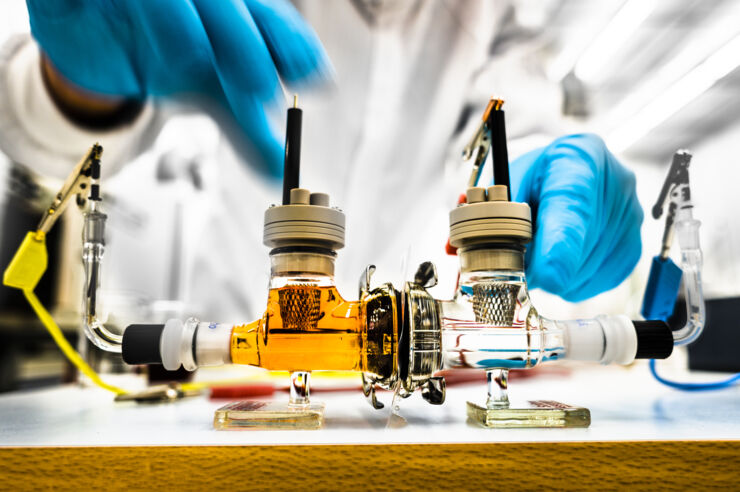 Photo credit THOR BALKHEDDescription of Lab
Photo credit THOR BALKHEDDescription of Lab
The Chemistry lab has activities focused on organic chemistry and electrochemistry. The first type of activity is the design and synthesis of new sustainable organic electrochemically active materials for novel medical, electronics, energy applications. The activity is to create new materials (catalyst, electrolyte, electrode, redox molecule) for the next generation of electrochemical energy devices (fuel cells, batteries, supercapacitors, electrolysers).
Key features
- Classical organic synthetic chemistry lab with the possibility for scaling up reaction up to a 10-liter reactor.
- Expertise in the design and synthesis of doped conjugated polymers (n-and p-types) for various applications in organic electronics and energy devices.
- Expertise in the synthesis of redox molecules, redox active polymers and modification of lignins.
- Formulation of nanocomposites between inorganic nanoparticles and organic polymers.
- Design and synthesis of special polymer electrolytes and ionic selective membranes based on polypeptides and polysaccharides for various electrochemical energy technologies.
- Glove box experiments for reactive metals used in organic batteries.
- Broad range of electrochemical methods to characterize the kinetics of reaction, the transport of ions, and mechanisms for charge storage.
- H2 electrochemical technologies (storage in organic molecules, electrolysers and fuel cells)
- Expertise in organic redox flow batteries (electrode reaction, transport in membranes)
- Thermogalvanic cells based on organic polymer electrolytes and organic electrodes.
Equipment & Resources
Synthetic chemistry lab
- 16 fume hoods
- Rotovaporators (0.5 to 5 liters)
- Chemical reactors (0.1 to 10 liters)
- Centrifuges (0.001 to 1 liters)
- Tip sonicator
- Homogenization
- Solvent purification
- Ovens
Electrochemistry lab
- Ultrapure water system
- Rotating disk electrode set-up
- Electrochemical flow cells for electrolysers
- Redox flow battery cells
- Fuel cells
- H2, O2 gas humidity system for fuel cells
- Electronic load
- H2 electrolysers
- High power source for electrolyzers
- Permeability meter coupled to mass spectrometer
- Glove box for alkali metal batteries
- Cold press
- Fume hood
- Solid state coin cell battery line
- Electrochemical potentiostats and bi-potentiostat
- Thermogalvanic set up
- SourceMeters (Keithely 2600 series)
- Ovens
- High temp. oven
- Vacuum oven
Measurement and Analysis Lab
- Desktop 13C and 1H-NMR (in-situ) (Spinsolve 80 ULTRA)
- Optical absorption spectroscopy (in-situ)
- Differential Scanning Calorimeter
- Thermogravimetry
- Viscosimeter (Malvern)
- Gel Permeation Chromatography (GPC Agilent 1260 Infinity)
- Polarized microscope (Nikon LV100ND)
- Particle size analyzer (Mastersizer 3000)
 Photo credit THOR BALKHEDDescription of Lab
Photo credit THOR BALKHEDDescription of Lab